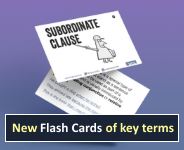Statement, question, command and exclamation: discourse functions
In this starter activity we will look at text examples drawn from our corpus and think about how the clause types statement, question, command, and exclamation function within authentic discourse.
Click on the interactive whiteboard icon (top right) and work through the following slides with students. Read each extract and analyse it by answering the accompanying questions. After each extract, there are some suggestions and pointers.
Welcome back!

Englicious is totally free for everyone to use!
But you will have to log in to see our library of teaching resources.
If you don’t have an account, that’s perfectly OK. You can register (for free).
It only takes a minute or two.
»
- Printer-friendly version
- Log in to view or leave comments

